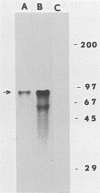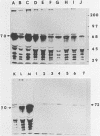Abstract
Plasmodium falciparum histidine-rich protein 2 (PfHRP-2) is a water-soluble protein released from parasitized erythrocytes into in vitro culture supernatants. This study sought to determine whether PfHRP-2 could be detected in the plasma of humans with P. falciparum malaria. A monoclonal antibody (1E1) is described that binds to PfHRP-2. By using monoclonal antibody 1E1, PfHRP-2 was identified by Western blot (immunoblot) analysis in the plasma of 37 of 39 (95%) patients experiencing either a first or repeat episodes of P. falciparum malaria and by dot blot analysis in the plasma of 40 of 41 patients tested. PfHRP-2 was not detected in 30 control, uninfected subjects. The current demonstration of PfHRP-2 in plasma, plus the fact that it is a structurally well-characterized molecule present in all natural isolates of P. falciparum tested, makes PfHRP-2 of interest for its potential effects on the host immune system and as an antigen for specific diagnosis of malaria.
Full text
PDF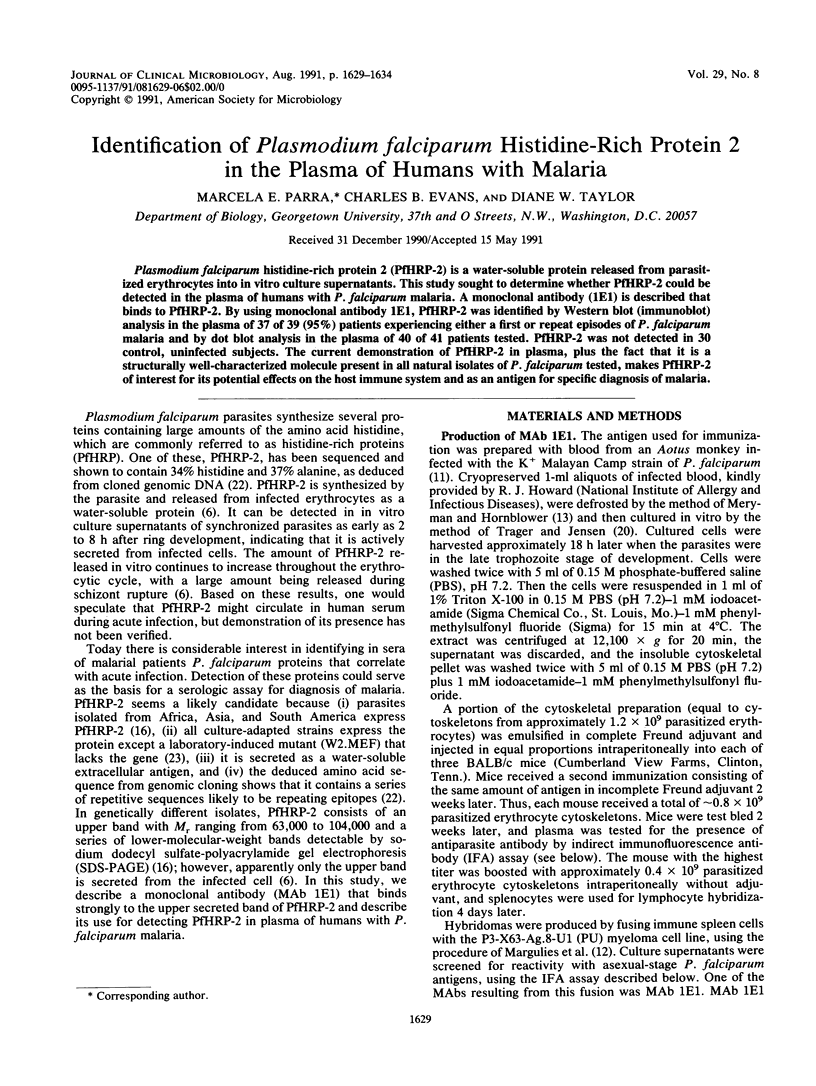
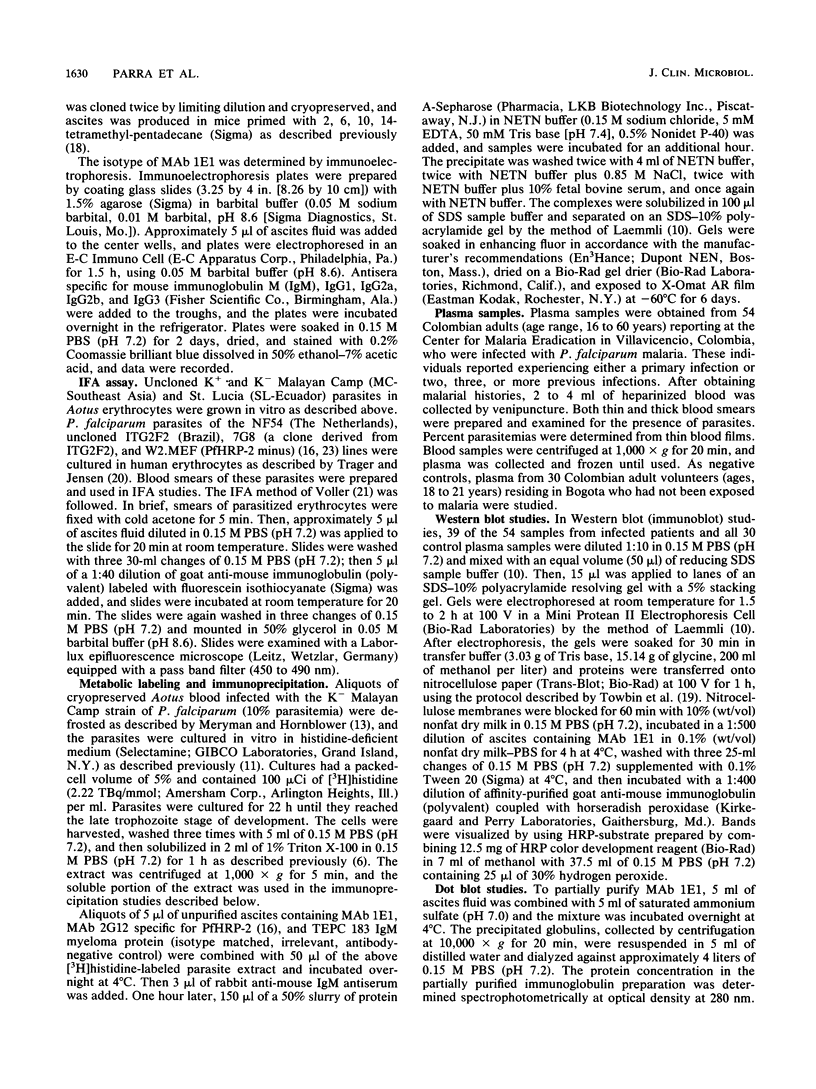
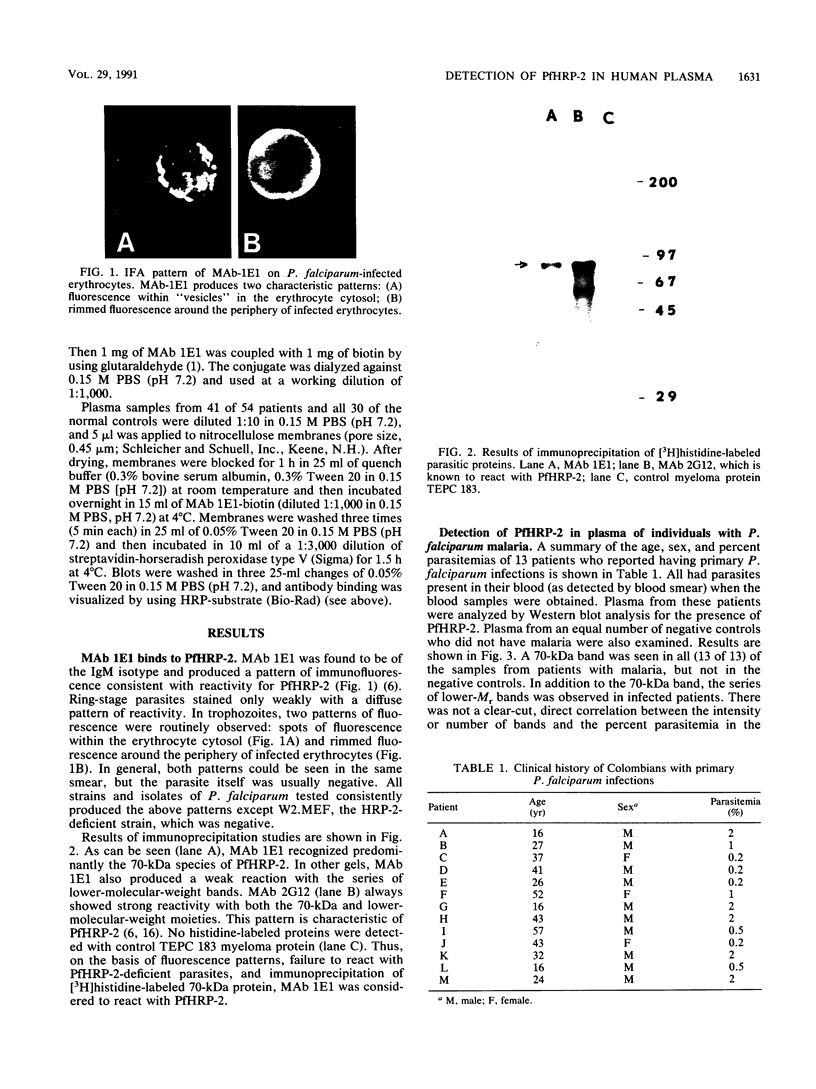
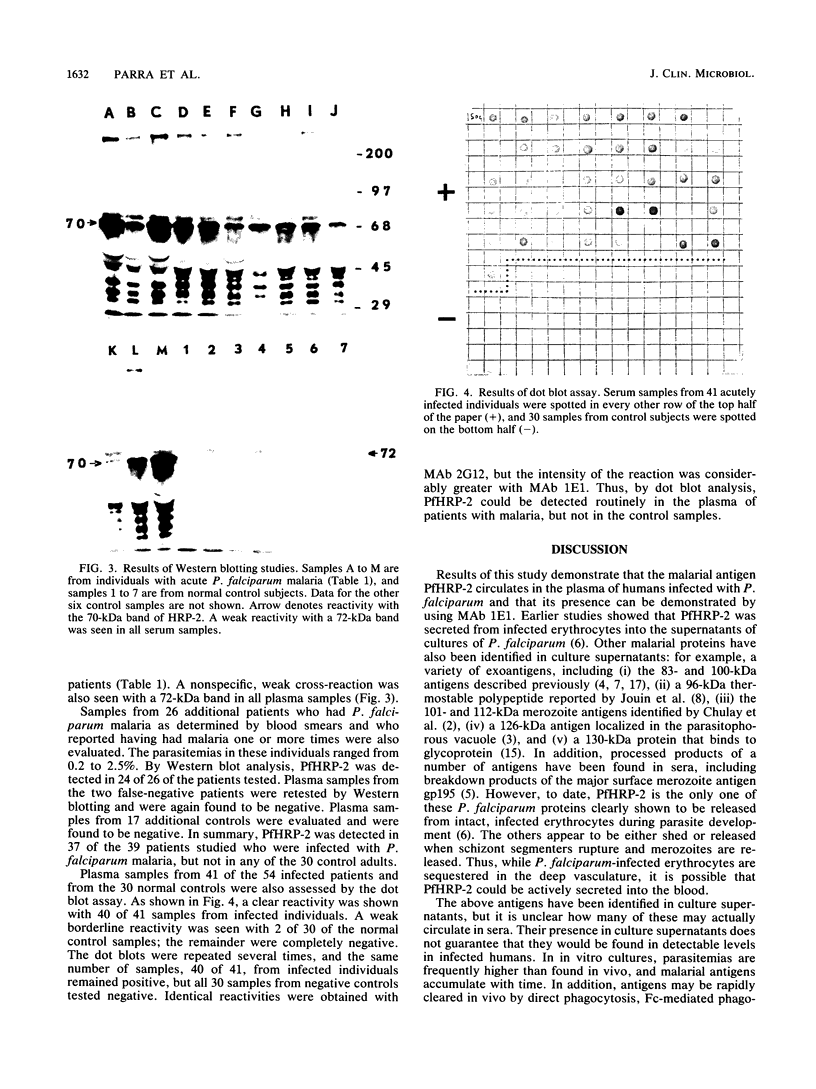
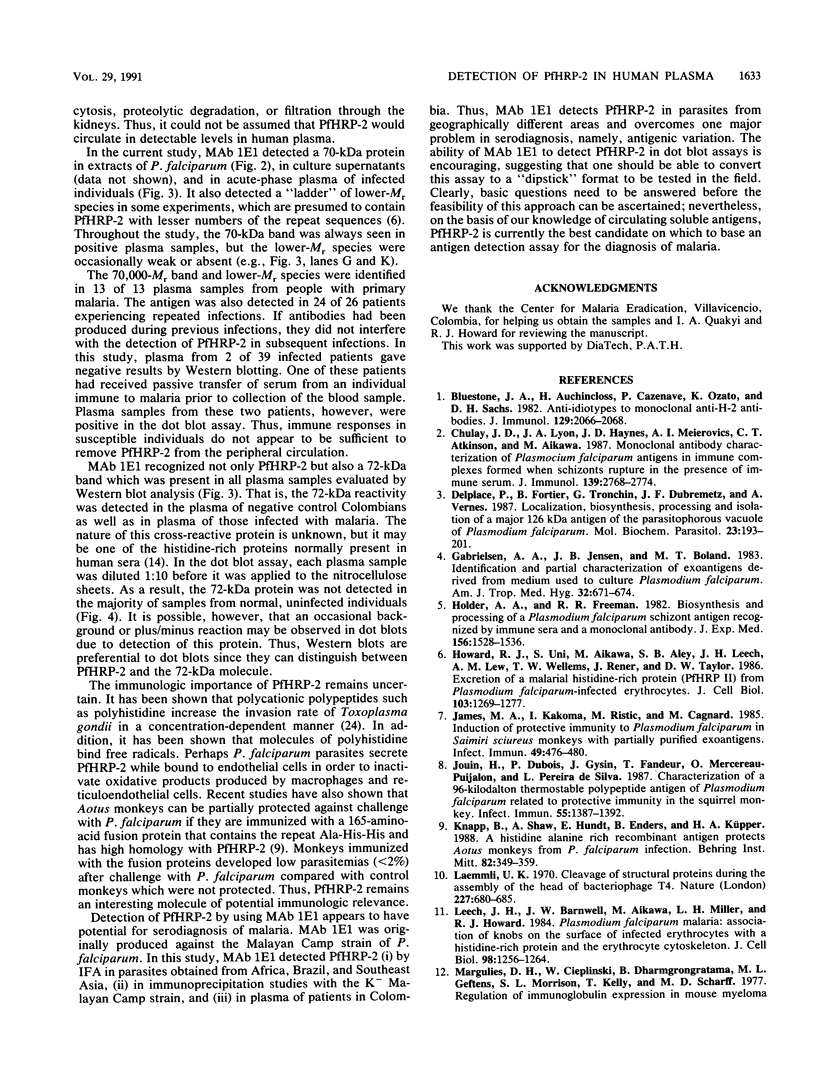
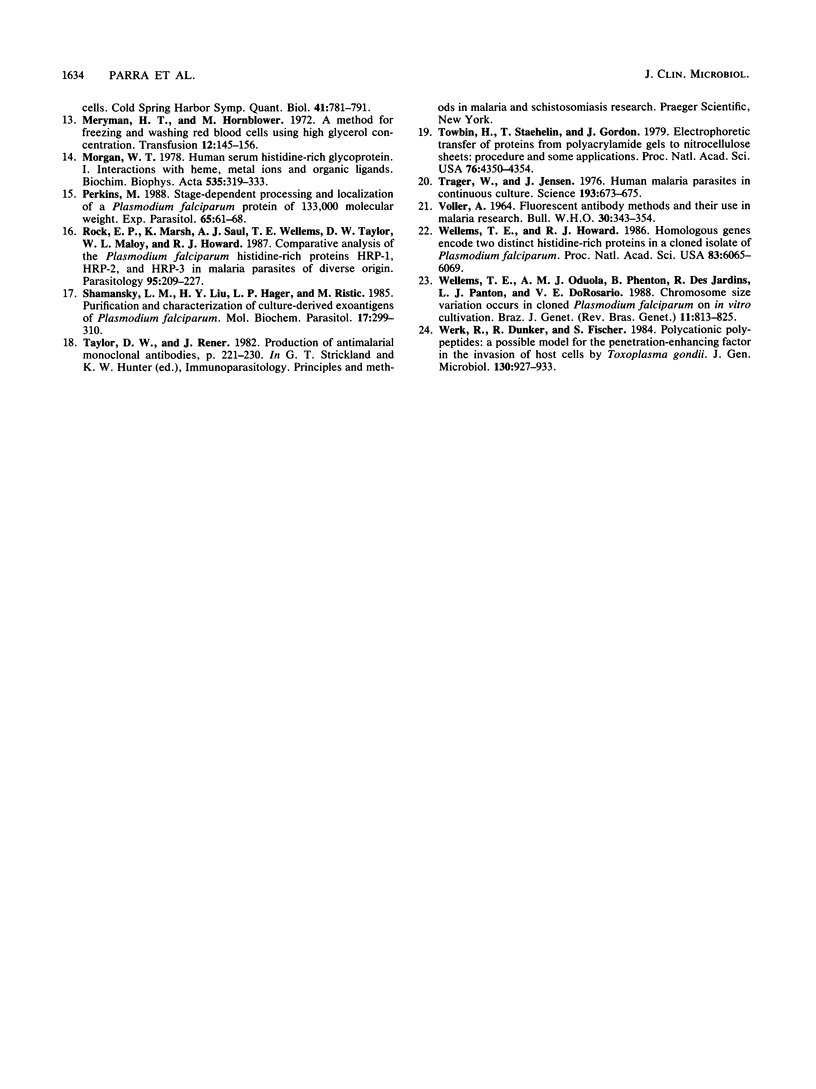
Images in this article
Selected References
These references are in PubMed. This may not be the complete list of references from this article.
- Bluestone J. A., Auchincloss H., Jr, Cazenave P. A., Ozato K., Sachs D. H. Anti-idiotypes to monoclonal anti-H-2 antibodies. III. Syngeneic anti-idiotypes on antibodies induced by in vivo administration of xenogeneic anti-idiotypes. J Immunol. 1982 Nov;129(5):2066–2068. [PubMed] [Google Scholar]
- Chulay J. D., Lyon J. A., Haynes J. D., Meierovics A. I., Atkinson C. T., Aikawa M. Monoclonal antibody characterization of Plasmodium falciparum antigens in immune complexes formed when schizonts rupture in the presence of immune serum. J Immunol. 1987 Oct 15;139(8):2768–2774. [PubMed] [Google Scholar]
- Delplace P., Fortier B., Tronchin G., Dubremetz J. F., Vernes A. Localization, biosynthesis, processing and isolation of a major 126 kDa antigen of the parasitophorous vacuole of Plasmodium falciparum. Mol Biochem Parasitol. 1987 Apr;23(3):193–201. doi: 10.1016/0166-6851(87)90026-0. [DOI] [PubMed] [Google Scholar]
- Gabrielsen A. A., Jr, Jensen J. B., Boland M. T. Identification and partial characterization of exoantigens derived from medium used to culture Plasmodium falciparum. Am J Trop Med Hyg. 1983 Jul;32(4):671–674. doi: 10.4269/ajtmh.1983.32.671. [DOI] [PubMed] [Google Scholar]
- Holder A. A., Freeman R. R. Biosynthesis and processing of a Plasmodium falciparum schizont antigen recognized by immune serum and a monoclonal antibody. J Exp Med. 1982 Nov 1;156(5):1528–1538. doi: 10.1084/jem.156.5.1528. [DOI] [PMC free article] [PubMed] [Google Scholar]
- Howard R. J., Uni S., Aikawa M., Aley S. B., Leech J. H., Lew A. M., Wellems T. E., Rener J., Taylor D. W. Secretion of a malarial histidine-rich protein (Pf HRP II) from Plasmodium falciparum-infected erythrocytes. J Cell Biol. 1986 Oct;103(4):1269–1277. doi: 10.1083/jcb.103.4.1269. [DOI] [PMC free article] [PubMed] [Google Scholar]
- James M. A., Kakoma I., Ristic M., Cagnard M. Induction of protective immunity to Plasmodium falciparum in Saimiri sciureus monkeys with partially purified exoantigens. Infect Immun. 1985 Sep;49(3):476–480. doi: 10.1128/iai.49.3.476-480.1985. [DOI] [PMC free article] [PubMed] [Google Scholar]
- Jouin H., Dubois P., Gysin J., Fandeur T., Mercereau-Puijalon O., da Silva L. P. Characterization of a 96-kilodalton thermostable polypeptide antigen of Plasmodium falciparum related to protective immunity in the squirrel monkey. Infect Immun. 1987 Jun;55(6):1387–1392. doi: 10.1128/iai.55.6.1387-1392.1987. [DOI] [PMC free article] [PubMed] [Google Scholar]
- Knapp B., Shaw A., Hundt E., Enders B., Küpper H. A. A histidin alanine rich recombinant antigen protects Aotus monkeys from P. falciparum infection. Behring Inst Mitt. 1988 Apr;(82):349–359. [PubMed] [Google Scholar]
- Laemmli U. K. Cleavage of structural proteins during the assembly of the head of bacteriophage T4. Nature. 1970 Aug 15;227(5259):680–685. doi: 10.1038/227680a0. [DOI] [PubMed] [Google Scholar]
- Leech J. H., Barnwell J. W., Aikawa M., Miller L. H., Howard R. J. Plasmodium falciparum malaria: association of knobs on the surface of infected erythrocytes with a histidine-rich protein and the erythrocyte skeleton. J Cell Biol. 1984 Apr;98(4):1256–1264. doi: 10.1083/jcb.98.4.1256. [DOI] [PMC free article] [PubMed] [Google Scholar]
- Meryman H. T., Hornblower M. A method for freezing and washing red blood cells using a high glycerol concentration. Transfusion. 1972 May-Jun;12(3):145–156. doi: 10.1111/j.1537-2995.1972.tb00001.x. [DOI] [PubMed] [Google Scholar]
- Morgan W. T. Human serum histidine-rich glycoprotein. I. Interactions with heme, metal ions and organic ligands. Biochim Biophys Acta. 1978 Aug 21;535(2):319–333. doi: 10.1016/0005-2795(78)90098-3. [DOI] [PubMed] [Google Scholar]
- Perkins M. Stage-dependent processing and localization of a Plasmodium falciparum protein of 130,000 molecular weight. Exp Parasitol. 1988 Feb;65(1):61–68. doi: 10.1016/0014-4894(88)90107-5. [DOI] [PubMed] [Google Scholar]
- Rock E. P., Marsh K., Saul A. J., Wellems T. E., Taylor D. W., Maloy W. L., Howard R. J. Comparative analysis of the Plasmodium falciparum histidine-rich proteins HRP-I, HRP-II and HRP-III in malaria parasites of diverse origin. Parasitology. 1987 Oct;95(Pt 2):209–227. doi: 10.1017/s0031182000057681. [DOI] [PubMed] [Google Scholar]
- Shamansky L. M., Liu H. Y., Hager L. P., Ristic M. Purification and characterization of culture-derived exoantigens of Plasmodium falciparum. Mol Biochem Parasitol. 1985 Dec;17(3):299–310. doi: 10.1016/0166-6851(85)90004-0. [DOI] [PubMed] [Google Scholar]
- Towbin H., Staehelin T., Gordon J. Electrophoretic transfer of proteins from polyacrylamide gels to nitrocellulose sheets: procedure and some applications. Proc Natl Acad Sci U S A. 1979 Sep;76(9):4350–4354. doi: 10.1073/pnas.76.9.4350. [DOI] [PMC free article] [PubMed] [Google Scholar]
- Trager W., Jensen J. B. Human malaria parasites in continuous culture. Science. 1976 Aug 20;193(4254):673–675. doi: 10.1126/science.781840. [DOI] [PubMed] [Google Scholar]
- VOLLER A. FLUORESCENT ANTIBODY METHODS AND THEIR USE IN MALARIA RESEARCH. Bull World Health Organ. 1964;30:343–354. [PMC free article] [PubMed] [Google Scholar]
- Wellems T. E., Howard R. J. Homologous genes encode two distinct histidine-rich proteins in a cloned isolate of Plasmodium falciparum. Proc Natl Acad Sci U S A. 1986 Aug;83(16):6065–6069. doi: 10.1073/pnas.83.16.6065. [DOI] [PMC free article] [PubMed] [Google Scholar]
- Werk R., Dunker R., Fischer S. Polycationic polypeptides: a possible model for the penetration-enhancing factor in the invasion of host cells by Toxoplasma gondii. J Gen Microbiol. 1984 Apr;130(4):927–933. doi: 10.1099/00221287-130-4-927. [DOI] [PubMed] [Google Scholar]



